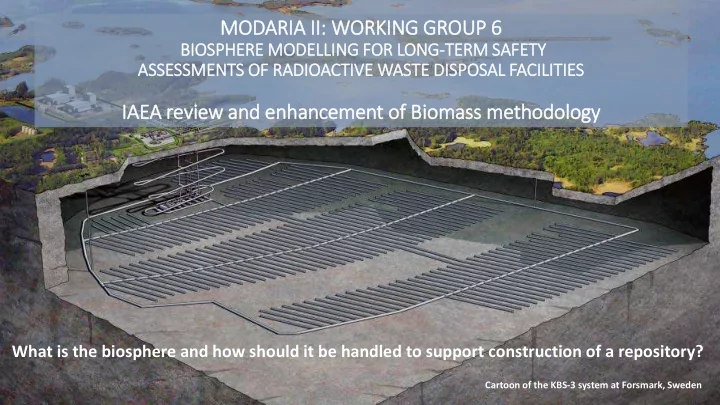

MO MODARIA I II: W WORKING NG G GROUP 6 6 BIOSPH PHERE M ERE MODELLING F FOR L R LONG NG-TERM S RM SAFETY ASSE SSESSM SSMENTS O OF RADI DIOACT CTIVE VE W WASTE DI DISP SPOSAL L FACI CILI LITIES IAEA r revie eview a and en enhancement o of Bi Biomass m methodolo logy What is the biosphere and how should it be handled to support construction of a repository? Cartoon of the KBS-3 system at Forsmark, Sweden
WORKING GROUP 6 IAEA Biosphere Modelling Methodological Documents • BIOMASS-6. Reference Biospheres for Solid Radioactive Waste Disposal, Report of BIOMASS Theme 1 of the BIOsphere Modelling and ASSessment Programme (2003) • TECDOC 1799. Environmental Change in Post-Closure Safety Assessment of Solid Radioactive Waste Repositories. Report of WG3 EMRAS II (2016) • Common Framework for Addressing Climate Change and Landscape Development in Post-Closure Radiological Assessment of Solid Waste Disposal. Report of WG6 of MODARIA, submitted to IAEA
WORKING GROUP 6 BIOMASS Methodology enhancements Assessment Context Climate development & downscaling Biosphere system identification FEP list and and justification Geosphere screening (discharge area) Site under- Biosphere system descriptions Near Surface standing Human actions, wildlife investigation methods Potentially exposed group Data and landscape definition human/wildlife development model selection Principles for critical Biosphere and supporting model principles group selection definition Conceptual model, mathematical Protection of the model & data environment Calculation & communication Confidence building
WORKING GROUP 6 Developments i in biosphere m modelling s since ce B BIOMASS-6 Experience from examples of practical application of BIOMASS-6 since 2001 • Experience of site characterisation at real sites • - Finland, Sweden, France, Spain, USA, UK, Canada … others… Science developments, • - Understanding of climate change and landscape evolution - Ecosystem understanding and representation - Methods in toxicology and multiple stressors Mathematical representation of processes • Coherent link to the remainder of the safety assessment • - e.g. via transport of elements and site development Special models for special radionuclides, C-14, Cl-36 and Se-79 • Wider range of assessment endpoints: • - complementary indicators and - those relevant to non-human biota Regulatory development and experience of assessment review •
WORKING GROUP 6 Progress to date shows us that the task is to evaluate, update, clarify and as appropriate, extend the BIOMASS-6 methodology, and deliver a report that: • Describes the biosphere assessment strategy and how it links to the overall safety assessment so as to support transparent evaluation against protection objectives • Builds on the biosphere concept and describes the lessons learned since 2001 , including from the BIOPROTA program • Describes supporting information/system description models needed for dose modelling • Extends consideration to a wider range of geographical environments • Links landscape environmental change ( MODARIA l ) to dose modelling • Assesses latest science that supports all the above, and • Describes how site understanding functions as basis for model development
WORKING GROUP 6 General task… cont. • Evaluates discharge areas, and how to define areas/volumes of interest corresponding to the protection objectives • Shows how to analyse and address uncertainties and correlations • Examines methods for presenting and communicating results so as to enhance stakeholder confidence • Provide real examples of the application of the enhanced methodology Hypothetical radionuclide flow path (Lindborg et al. 2010)
WG6 Format WORKING GROUP 6 BIOMASS methodology outline Sub-activities • Assessment context • Analogue environments • Guidance on critical and other exposure groups • Confidence and uncertainties • Guidance on application of data • Specific real sites as examples • Biosphere system identification and justification • Potential Exposure Groups • Biosphere system principal components • Environmentalchange and effects • Biosphere system classification • Climate and landscape development • Application to specific examples • Safety assessment lessons learnt • Biosphere system description • Procedure for biosphere system description • Biosphere model development Meetings and field studies • Annual meeting Vienna Report writing • Interim meetings • Defined writers and editors • BIOPROTA meetings • Input from participants • Analogue environment studies • Review of scientific findings and results Periglacial environment, West Greenland
WORKING GROUP 6 Scope of activities includes: • Deep geological disposal • Near surface disposal • All types of (solid) radioactive waste • Wide range of geographical environments • Taking account of on-going work in the parallel BIOPROTA project on review and enhancement of the BIOMASS-6 methodology • Legacy sites involving mixtures of contaminated land, old disposal facilities and in-situ disposal • Greater focus on the first few thousand years Landscape development data flow chart (Lindborg et al. 2010)
WG6 interim meeting 2017 Held at the Headquarters of Swiss Federal Nuclear Safety Inspectorate (ENSI), Brugg, Switzerland 10 – 12 May 28 participants from 10 IAEA Member States • Presentations on ideas to enhance the BIOMASS methodology • Defining report structure • Identifying tasks to be done •
This week : • Presentations on international experiences and scientific/technical developments. • Presentations and discussions on tasks identified within the WG. • Interim report presentation and discussions • Inputs from and integration of BIOPROTA-programme • Update work-plan with task allocation
The biosphere, an integral part of the entire system Join WG6! Join
Recommend
More recommend